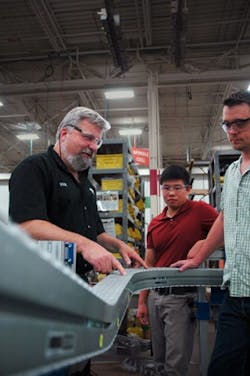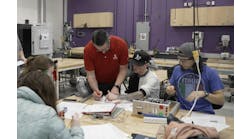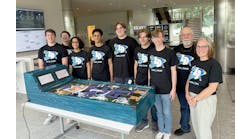What industry is doing to address the shortage of experienced technical employees
- How do the quickly changing consumer trends affect the design, form and function of packaging machinery?
- How do packaged goods manufacturers approach retrofitting?
- How much importance should the packaging equipment industry place on the IIoT and the productivity gains that big data promises?
- How will IP67 and IP69K components affect machine-design decisions?
As consumers grow hungrier and hungrier for packaged goods that satisfy their appetites for variety, it is having a profound effect on manufacturers that reaches all the way back to the machine builders that make the packaging equipment used in these production operations. Our panel of experts answer questions on topics ranging from changeover and retrofits to skilled employees, the Industrial Internet of Things (IIoT) and moving components out of the cabinet.
What is being done or can be done to address the shortage of experienced technical employees who can design, operate and maintain the new generation of technology and equipment and also have the ability to do the same with existing automation whose useful life will continue for years to come?
Figure 7: Dorner works closely with the local high school and community technical college to advocate for the engineering, manufacturing and packaging career paths, and it employs interns to work throughout the plant.
(Source: Dorner Manufacturing)
Finding skilled workers who are interested in manufacturing or packaging is a challenge. Here at Dorner, we have always taken steps to promote the manufacturing and packaging industries as viable, exciting careers. We depend on those highly skilled employees for our long-term success. The key is raising awareness to this industry and the possibilities it holds.
One of the things we’ve done at Dorner is work closely with the local high school and community technical college to advocate for the engineering, manufacturing and packaging career paths.
For example, the local high school’s trades program taught “how,” and the engineering program excelled at teaching “why.” But students in either program didn’t have technical skills or the desire to take the jobs in manufacturing that local companies were looking to fill.
The head of the high school’s technology and engineering department reached out to us and other local manufacturers to find out what they wanted from a manufacturing program. What emerged was the Design, Engineering and Manufacturing Center, comprised of an innovation lab, two state-of the-art design labs and a high-tech manufacturing shop.
More importantly, the center’s curriculum seeks to engage students in the process of design and manufacturing, not just the end product. Instead of just following directions to make a flashlight, a desk or a fidget spinner, they design it from the ground up, learning about materials, tolerances, budgets and timelines along the way.
Students also see how what their learning fits into the manufacturing industry at large. The local business alliance has set up an annual tour where students visit manufacturers and the local technical college, where they see the same cutting-edge technology being used in the real world (Figure 7).
Plus, 20 to 30 of these high-school students apprentice each year at local companies such as Dorner, starting full-time over the summer and then 10 to 12 hours each week during the school year. Of the two to three apprentices Dorner has each year, we make a point of rotating them around the shop floor, so that they learn the entire process that goes into manufacturing our products.
Dorner also participates in the Amazing Packaging Race at Pack Expo 2017. The Amazing Packaging Race involves students studying engineering and packaging in colleges from across the country to race around Pack Expo to solve packaging problems and learn about the possibilities of a career in packaging.
Manufacturing and packaging are great industries to be a part of. These are just some of the steps Dorner is doing to advocate for our industry.
Education, Education, Education. Many companies are teaming up with their local universities and technical schools to offer degrees in mechatronics and industrial automation. We need to do a better job creating interest in these careers at an early age. Field trips to OEMs, end users and trade shows with an emphasis on sustainable employment and the need to focus on STEM courses even in high school should be the foundation of every elementary-school education.
One of the main ways to address this issue is by making automation systems easier to operate, especially remotely. Easier operation requires less training, and remote operation allows each employee to maintain more machines. For example, the PLC should have Web-server functionality built in, with the capability to create Web pages without any required knowledge of HTML programming. These Web pages can be viewed remotely via any Web browser from any Internet-connected device such as a laptop, smart phone or tablet, allowing fewer employees to support more machines, no matter where the employee is based.
Remote access is made even easier when the PLC supplier provides app access via smart phones and tablets. As compared to browser-based access, apps are faster to activate and provide quicker interaction with the PLC. Because of these and other benefits, apps are taking over the commercial world for accessing services via smart phones and tablets and will be making similar strides in the industrial arena.
Another important aspect of remote access is email and FTP support. Email support allows the PLC to push notifications and alerts to users, and FTP support allows users to transfer large files to and from the PLC.
If we could automate the format change in the machines, error-proof the systems to ensure correct formats are set for the upcoming production schedule and provide visual alerts for the problems areas with little more details, it will allow us to have fewer experienced or highly technical maintenance staff, and line operators would be able to assist in ensuring that the machines are production-ready.
Machine design is going to require ever more talented engineers, and this will continue to be a challenge. Likewise, the skills to handle mechanically complex legacy equipment and non-intuitive legacy controls will remain in high demand and low availability. The justification for new capital spending on systems that provide order-of-magnitude better diagnostics, work instructions, HMI graphics and predictive-maintenance monitoring will come about in part because of the skills gap.
What does not work is to try and retrofit advanced capabilities into 20- and 30-year-old machines. Much of the hope for IIoT is to make brownfield assets more productive. Again, there will be incremental improvements with this approach. Automated changeover is one such retrofit gaining in popularity, using networked, machine-mounted, sealed drives to do things such as precisely and quickly adjust conveyor guide rails. The brownfield is really an interim step, and a worthwhile one, to get familiar with new technologies before committing to wholesale change.
We are using technologies such as HoloLens from Microsoft to augment reality and bring our techs to the site virtually and fast.
ALSO READ: The future of packaging machinery design
The capacity to capitalize and transmit the knowledge to the new employees has become critical for manufacturers to stay competitive. The use of the digital twin, which allows manufacturers to capitalize on the knowledge, and related technology such as virtual reality and augmented reality can help the technical employees with less experience to get up and running faster.
Mike Bacidore is the editor in chief for Control Design magazine. He is an award-winning columnist, earning a Gold Regional Award and a Silver National Award from the American Society of Business Publication Editors. Email him at [email protected].














